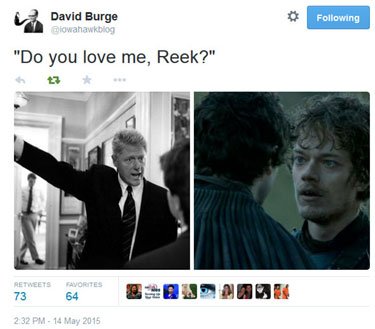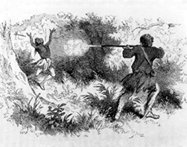Archive for May, 2015
17 May 2015


Dan Greenfield explains the community of fashion’s preferred way of looking at the interaction of Islamic terrorism and Free Speech.
Call it Schrödinger’s Jihad. The more famous Schrödinger’s Cat is a paradox in which a cat in a sealed box with poison that has a 50 percent chance of being released is in an indeterminate state. It is neither dead nor alive until someone opens the box.
In Schrödinger’s Jihad, the Muslim terrorist is in an indeterminate state until some Western observer opens the box, collapses his wave function and radicalizes him. The two Muslim Jihadists were in an indeterminate state until Pamela Geller and Bosch Fawstin and the other “provocateurs†suddenly turned them into terrorists in a matter of days or weeks. It didn’t matter that Elton Simpson, one of the Garland terrorists, had already been dragged into court for trying to link up with Jihadists in Africa.
Every Muslim is and isn’t a terrorist. He is both a peaceful spiritual person who is eager to embrace our way of life and a violent killer who can be set off by the slightest offense. Like the cat in the box that is neither dead nor alive, he is both violent and peaceful, moderate and extremist, a solid citizen and a terrorist. He does not choose which of these to be or to become; we decide what he will be.
The Jihadist paradox is that the Muslim terrorist is always defined by what we do, not by what he does.
Read the whole thing.
16 May 2015
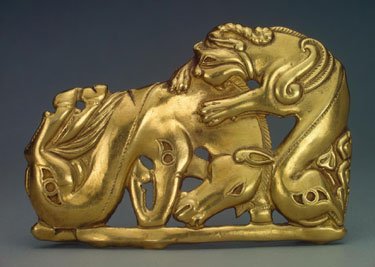
Period: Early Iron Age
Date: Sakae Culture (Scythian). 5th – 4th century BC
Archaeological site: Siberia
Material: gold
State Hermitage Museum, St. Petersburg
Hat tip to Ratak Monodosico.
16 May 2015

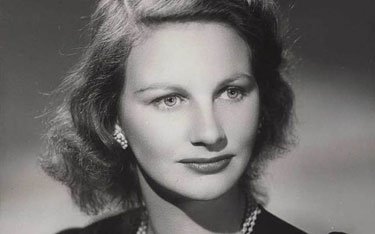
The Telegraph does the best obituaries, and its subjects seem to live the best lives.
The Dowager Marchioness of Reading, who has died aged 96, was a society beauty of the 1930s and 1940s and a woman of independent spirit.
She was one of the first British women to get a pilot’s licence, competed on the prewar stock car racing circuit, and became a rally driver in the 1950s. In later life she became a campaigner for animal rights and an outspoken English nationalist.
As Harold Brooks-Baker, the former publishing director of Burke’s Peerage, once observed, Margot Reading had views “diametrically opposed to most sane peopleâ€. At no time was this more clear than in 1998 when, after the maverick Tory politician Alan Clark paid tribute to the “martial spirit†of English football supporters who had gone on the rampage in Marseille, she wrote a letter to The Spectator in which she observed: “We are a nation of yobs. Now we don’t have a war, what’s wrong with a good punch-up?â€
In a later interview she elaborated on her views. “I love England so much and I just feel that the so-called hooligans are just sort of over-enthusiastic. How is it that we conquered the world and that our armies went over the top? It is because we are a nation of fighters … What an English tough guy does is to fight with his fists, which is a good clean fight… With so many milksops, and Left-wing liberals and wetties around, I just rejoice in the fact that there are people who keep up our historic spirit.â€
Her comments came in for severe criticism, prompting her eldest son, the Marquess of Reading, to beg her not to take any more telephone calls. “I am very fond of my mum, but I do not always agree with her,†he explained.
One of three sisters, she was born Margot Irene Duke on January 11 1919. Her father, Percy Duke, was said to have been the last man to wear a wing collar on the floor of the Stock Exchange and , for reasons which remain obscure, divided the world into people he called “George,†and those he called “McGregorâ€
Read the whole thing.
Hat tip to Rafal Heydel-Mankoo.
14 May 2015

You can display old rugs like this as art.

Good old ones have lots of wear, or costs lots of thousands.
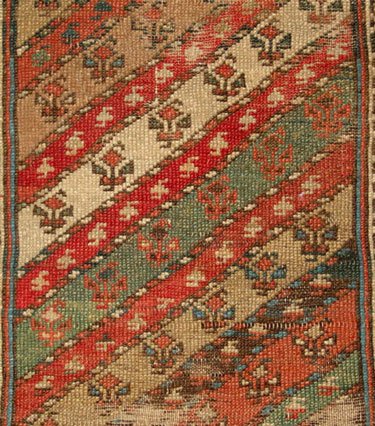
Close-up view of pattern.
Described by seller as an “antique Caucasian Gendje rug, 19th Century, size: 37†x 65â€, natural, vegetable dyes, worn condition.”
JBOC’s notes on Gendje rugs.
I thought I’d post some photos, since Bird Dog over at Maggies’s Farm is an aficionado of old rugs. Tomorrow, I’ll tell you just how I came to appreciate shot-down old carpets exhibiting lots of wear.
14 May 2015


Rich Lowry adds another large one to the First Lady’s list of personal affronts.
Michelle Obama gave a commencement address at Tuskegee University that was a ringing call for the graduates not to be discouraged by her whining.
Much of the first lady’s speech was what is right and proper for a Tuskegee commencement, drawing on the story of the determination and skill of the Tuskegee Airmen. But she devoted a long passage to her own struggles that was off key and characteristically self-pitying.
Few women in modern America have been the focus of as much adulation as Michelle Obama, a Princeton University and Harvard Law School graduate who was making almost $270,000 by the time her husband was elected senator. She is routinely lionized for her beauty and her public spiritedness.
Yet, the first lady often strikes an aggrieved note when talking about her experience in America (her notorious comment in 2008 was that “for the first time in my adult lifetime I’m really proud of my country.â€). Her gloss on the famous Wallis Simpson line is apparently that you can never be too rich, too thin or too easily offended.
At Tuskegee, she related a series of inconsequential gibes or perceived insults mostly from 2008 that, for her, loom large enough to share with graduating seniors years later.
The first lady cited a controversial New Yorker cover during that campaign of her sporting an Angela Davis-style Afro and a gun. The image was meant to satirize “misconceptions and prejudices†about the Obamas, in the words of the publication’s editor, David Remnick.
The first lady said “it knocked me back a bit.†Give her this: Few of us know the pain of being featured on a cover of one of the nation’s most respected magazines in a spoof meant to illustrate how our critics are mean-spirited loons.
(Remnick went on to further demonstrate his hostility to the Obamas by writing an admiring 672-page biography of the president.) …
In her Tuskegee address, at least Michelle Obama urged the graduates not to be daunted by slights (and more meaningful obstacles, like rotten schools). She commended to them the example of herself, “the fully-formed first lady who stands before you today.â€
Even though Michelle Obama didn’t mention the word, what she was discussing was “microaggressions.†It is the trendy term on college campuses for often inadvertent offensiveness, such as Barack Obama, once upon a time, being mistaken for a waiter when he wore a tuxedo at an event.
The idiocy of the concept of the microaggression is its underlying premise that only people who belong to certain select groups ever suffer indignities or humiliations, when they are, of course, endemic to the human condition. George Orwell once said that every life seen from the inside is a series of defeats.
Read the whole thing.
14 May 2015

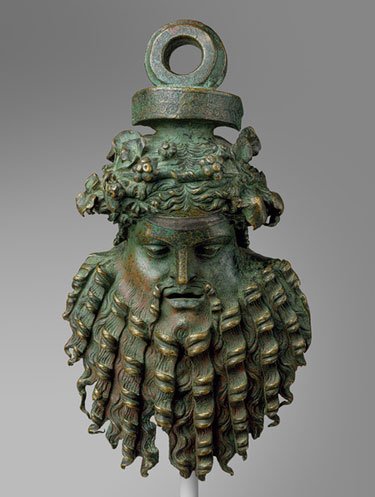
Bronze handle attachment in the form of a mask
Period: Late Hellenistic or Early Imperial
Date: 1st century B.C–1st century A.D.
Culture: Greek or Roman
Medium: Bronze
Dimensions: H. 10 in. (25.4 cm)
Classification: Bronzes
Credit Line: Bequest of Walter C. Baker, 1971
Accession Number: 1972.118.98
Despite all the change and innovation in Hellenistic iconography, there was also continuity. The three masks in this case demonstrate the tendency to perpetuate, if not to revive, styles going back to the Classical and even to the Archaic period, a tendency that gained impetus from the second century B.C. on, as Greek artists were being called upon to cater to the demands of the Roman art market.
Images related to Dionysos, Greek god of intoxication and ecstasy, were well suited to the luxurious and hedonistic life that wealthy Romans led in their villas. These handle attachments were for wine buckets. The wreath of ivy leaves and the fillet crossing the forehead are associated exclusively with the god of wine and his followers. The mask brings to mind Archaic images of Dionysos, who until the fifth century B.C. was always shown with long hair and a beard. But the pointed, equine ears on these masks mark them as representations of satyrs or silenoi, the quasi-human woodland creatures in the rowdy entourage of the god.
Metropolitan Museum via Belacqui.
13 May 2015

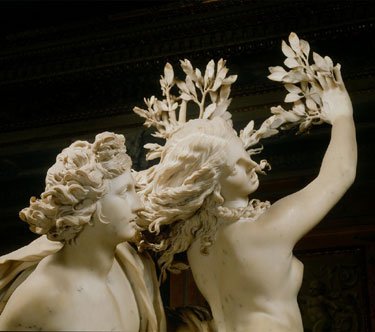
Detail, Gian Lorenzo Bernini, Apollo and Daphne, 1621-1625, Galleria Borghese, Rome
Four student members of a Multicultural Affairs Advisory Board at Columbia editorialized recently about the hazard of representative elements of the Humanities canon proving triggering for students, particularly for minority students and the poor.
Instead of reading all the naughty bits in Ovid, they proposed that a bit more Toni Morrison might be in order.
During the week spent on Ovid’s “Metamorphoses,†the class was instructed to read the myths of Persephone and Daphne, both of which include vivid depictions of rape and sexual assault. As a survivor of sexual assault, the student described being triggered while reading such detailed accounts of rape throughout the work. However, the student said her professor focused on the beauty of the language and the splendor of the imagery when lecturing on the text. As a result, the student completely disengaged from the class discussion as a means of self-preservation. She did not feel safe in the class. When she approached her professor after class, the student said she was essentially dismissed, and her concerns were ignored.
Ovid’s “Metamorphoses†is a fixture of Lit Hum, but like so many texts in the Western canon, it contains triggering and offensive material that marginalizes student identities in the classroom. These texts, wrought with histories and narratives of exclusion and oppression, can be difficult to read and discuss as a survivor, a person of color, or a student from a low-income background.
The MAAB, an extension of the Office of Multicultural Affairs, is an advocacy group dedicated to ensuring that Columbia’s campus is welcoming and safe for students of all backgrounds. This year, we explored possible interventions in Core classrooms, where transgressions concerning student identities are common. Beyond the texts themselves, class discussions can disregard the impacts that the Western canon has had and continues to have on marginalized groups.
For example, another student who attended the forum shared that her Lit Hum professor gave her class the opportunity to choose their own text to add to their syllabus for the year. When she suggested the class read a Toni Morrison text, another student declared that texts by authors of the African Diaspora are a staple in most high school English classes, and therefore they did not need to reread them. Toni Morrison is a writer of both the African Diaspora and the Western world, and her novels—aside from being some of the most intellectually and emotionally compelling writing in the last century—should be valued as founding texts of the Western canon.
The student’s remark regarding Toni Morrison was not merely insensitive, but also revealing of larger ideological divides. This would have been an opportune moment for the professor to intervene. …
Students need to feel safe in the classroom, and that requires a learning environment that recognizes the multiplicity of their identities. The MAAB has been meeting with administration and faculty in the Center for the Core Curriculum to determine how to create such a space. The Board has recommended three measures: First, we proposed that the center issue a letter to faculty about potential trigger warnings and suggestions for how to support triggered students. Next, we noted that there should be a mechanism for students to communicate their concerns to professors anonymously, as well as a mediation mechanism for students who have identity-based disagreements with professors. Finally, the center should create a training program for all professors, including faculty and graduate instructors, which will enable them to constructively facilitate conversations that embrace all identities, share best practices, and think critically about how the Core Curriculum is framed for their students.
All this is perfectly understandable. If you come from a disadvantaged background, you are bound to know plenty of women who were raped by some Olympian deity in the guise of a bull or a swan, and you undoubtedly have a sister who was forced to change into a laurel tree to avoid the embraces of Apollo. Those kinds of memories are painful!
Hat tip to (T)Reason.
13 May 2015


His blog:
[S]talking deer in the Scottish Highland is the hardest, most physically demanding single activity I’ve ever done on camera. It doesn’t look like much. A nice walk up some hills, across the moors, in traditional Scottish kit, carrying nothing more cumbersome than a walking stick. You don’t even have to carry your rifle. The gamekeeper does that for you. The hills and peaks, the mountains of the Highlands are incredibly beautiful—the footing alternately firm and hard against flinty rock and hard packed soil—then soft and spongy among the heather and scrub of the moors, then steep, near vertical inclines. The idea is to walk up, at a reasonable pace, higher and higher, the incline gradual, legs fine, then not so fine, then burning with exertion. After a few miles, by which time, you’re congratulating yourself on having made it so far, the gamekeeper might spot a suitable animal through his binoculars—about a mile away. “If we sneak around the back that way—behind that mountain—and make our way quietly across that ridge—pop out over there-†he suggests, pointing at a harrowingly steep range of what sure as hell look like mountains to me, “we might just surprise him.†This is yet another climb requiring some skill and no small amount of exertion—and at least another hour—all in the cause of sneaking up on an animal who, more than likely will be gone by the time we arrive at our position. We spend a lot of time crawling through wet heather and brush. It’s raining in that kind of omnipresent, thin drizzle kind of way—almost a mist that the French used to call “Le Crachinâ€. Which is to say, by the time I finally manage to successfully shoot an old stag in the brain, I am pretty happy at the prospect of walking downhill for a change. But, no. Downhill, it turns out, is worse. MUCH worse. A couple of miles of relentless incline and my knees, deprived of the kind of shock-absorbent cushioning of my younger years, are in full rebellion. I’m hobbling like Long John Silver, making little grunting sounds with the impact of each step, trying, somehow to take it sideways all the way home.
Hat tip to Vanderleun.
13 May 2015

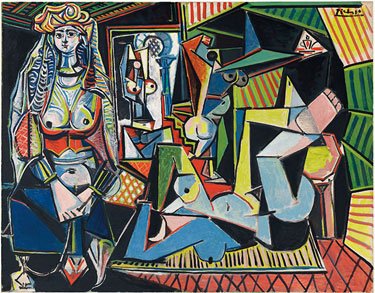
Visual News:
An anonymous buyer has just paid an astounding $179.36 million for Pablo Picasso’s 1955 painting Les femmes d’Alger (Version “Oâ€), putting it in top position in the world of very expensive artworks. The painting last sold in 1997 for a paltry $31.9 million.
Olivier Camu, Christie’s Deputy Chairman of Impressionist and Modern Art had these insights on the paintings history:
“Les femmes d’Alger, (Version “Oâ€) is the culmination of a herculean project which Picasso started after Matisse’s death, in homage to his lost friend and competitor, and which over a period of two months and after nearly 100 studies on paper and 14 other paintings led to the creation of this canvas in February 1955. Picasso painted a series of 15 variations on Delacroix’s Les femmes d’Alger, designated as versions A through O. Throughout his series, Picasso references the Spanish master’s two versions of the shared subject, intermingling their elements.â€
All of which shows that even the super-rich are not always financially sensible.
Is “Les femmes d’Alger” even arguably the greatest painting in the history of Western art? Not really. Is it even the greatest of all Picassos? Not really.
/div>

Feeds
|




